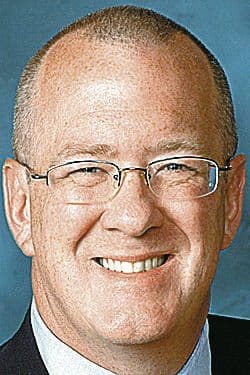I will soon deliver my annual forecast, so let’s review where we have come as an economy since the end of the Great Recession. The news is far more dismal than I prefer, but it is wise to know where we are coming from before discussing our future.
The Great Recession was deep and long. It stretched from December 2007 to June 2009, over which time U.S. employment declined by 5.2 percent. Indiana saw a deeper decline, with job losses accounting for 7.4 percent of our workers. Indiana actually fared better than should’ve been expected over this time. About half of recession losses to production occurred in consumer durable and business plant and equipment. As the nation’s most manufacturing-intensive state, we had to expect much higher job losses than a state like Florida, Virginia or California. We did, but the unemployment rate peaked well beneath the 1982 level, which is much lower than anticipated.
In 2011, I co-authored a study comparing Michigan and Indiana through the Great Recession. At its peak, I reported the unemployment rate in Michigan was a full 4.5 percent higher. Much of the difference was attributable to plant closures that were more concentrated in Michigan than in Indiana. I believe Indiana’s tax reforms, focus on fiscal solvency and more predictable business environment helped us weather the Great Recession.
This is good news so far, but states and regions with more volatile business sectors experience deeper recessions and more robust recoveries. So, from 2009 to today, Indiana should have enjoyed a far more robust economic recovery. In fact, the opposite occurred. From 2009 to the present, Indiana has underperformed the nation by growing jobs and GDP more slowly. Taking into account the Great Recession and the longest economic recovery in U.S. history, Indiana has created jobs at barely over half the rate of the nation as a whole.
Job creation in our state is not just low relative to the nation as a whole: The composition of jobs is decidedly inferior to the national average. As I’ve noted before, more than eight in 10 net new jobs nationwide have gone to workers with a college degree. The remaining two out of 10 jobs have gone to those with some college or an associate’s degree. The country simply is not creating jobs for workers who haven’t been to college.
The Indiana story is different. The single largest educational category of job growth since the start of the Great Recession has been workers without a high school diploma. Instead of eight of 10 jobs going to college graduates, Indiana has fewer jobs for college graduates than we did in 2007. This shift means Indiana’s economy is weakening over time.
GDP growth nationally has been almost twice as great since the start of the Great Recession as it has been in Indiana. Hoosier productivity growth is slower across all sectors, and Indiana’s long-term shift away from the national average on wages has continued. There seems to be very little official realization of these facts, particularly in the way we fund education and workforce development.
Last week, the state unveiled a program to increase training dollars on occupations that are declining in number, and which pay wages lower than they did in the Clinton administration. It is flabbergasting. In virtually every meaningful respect, Indiana’s recovery from the Great Recession has been a disappointment. It is time to have a cogent, well-informed debate about how to move forward. To do otherwise is to accept an unrelentingly stagnant status quo.
Michael J. Hicks, PhD, is the director of the Center for Business and Economic Research and the George and Frances Ball distinguished professor of economics in the Miller College of Business at Ball State University. His column appears in Indiana newspapers. Send comments to [email protected].




